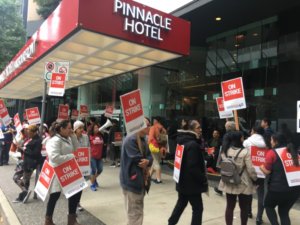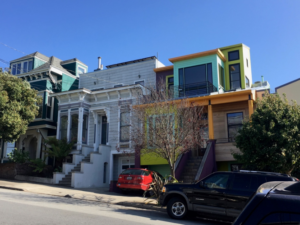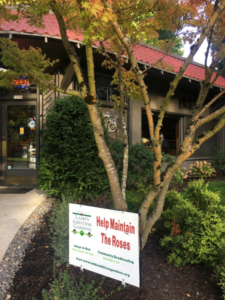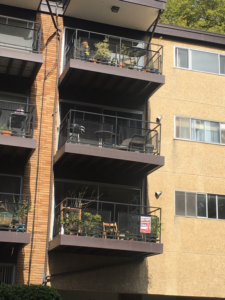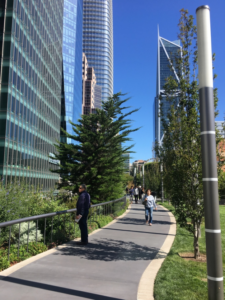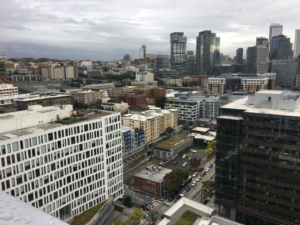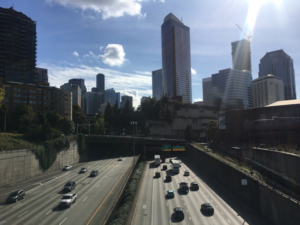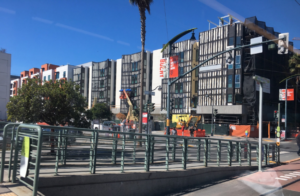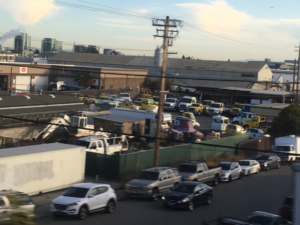Providing housing
In our travels from Vancouver to Palo Alto we were appalled by the shortages of affordable housing, and the number of people sleeping on the streets. Despite, and possible because of, higher salaries along the West Coast, housing is generally as unaffordable as in London. But the extremes are even more noticeable, as so little is being built compared with the number of jobs that are being created. For example, in a desirable location such as Menlo Park on the edge of Palo Alto with a population of 35,000, the median house is now worth $2.3 million, and proposals for building new homes on Stanford’s campus were turned down. Typical houses are built at a density of four to the acre around a large garage, and generally seem to be on one storey only. So sprawl is predictable.
Visitors from Europe may be shocked by the large numbers of people sleeping in the streets, in tents and in cars or even vans. California is the richest state in the richest country, yet 45,000 sleep on the streets of Los Angeles, up 50% since 2009. The numbers have also risen by 35% in Seattle and 18% in San Francisco. Half the nation’s homeless are in California. So as Marvin Gaye asked in his famous song what is going on?
The admirable Housing First policy does not seem to have overcome a problem of people sleeping in bus shelters in the city centre, or vehicles further out, as many have multiple problems in a state without a safety net. Rapid growth without proper spatial planning and development has produced displacement on what Europeans would consider an unacceptable scale. The title of the 2019 film The Last Blackman in San Francisco says it all. Requirements that houses should be of a minimum size or density or that developers should achieve ‘higher standards’ are as effective as earlier segregation policies in keeping the poor ‘in their place.’ Quality comes at a cost for someone.
New housing and the homeless
The visible homeless has generated a host of research in each of the cities we visited. A book on the loss of low rent housing and hotels in the Mission District of San Francisco (where I had stayed fifty years ago on a weekend urban studies course) criticises city policies for enabling a former working class area to be gentrified. This was against considerable community opposition. [1] The book concluded that community land trusts were needed to give poorer people a chance in competing for space. Homeless people sprawled over pavements or standing together in run-down areas are sign of failed urbanism. They must deter some people from using the streets and their shops and encourages them to use their cars instead or stay at home.
Jobs for those without qualifications have contracted. Menial jobs such as dealing with passengers at airports have either been replaced by machines or recent immigrants with poor English. It seems as if the attempts to open middle class opportunities to ethnic minorities in the wake of Martin Luther King’s assassination have only partly succeeded. It is the poorest who suffer most, as stories about the homeless bring out. Even in progressive Portland some 2% or 38,000 of Portland Metro’s population at some point in 2017 or seven times the official tally. In San Francisco the total is put at 10,000 and has been expanding rapidly, with job loss being the most common cause and with alcohol and drug addiction accounting for 18%; in other words most down and outs start off a quite ordinary people! Research publicised in The Economist argues that San Francisco’s policy of rent controls has perversely reduced the supply and therefore increased the cost of rental accommodation.[2]
My greatest surprise was not just the numbers of homeless people, including those living in camper vans to be near their work in Palo Alto, but the apparent loss of black Americans from the areas where they once lived. Extensive research in The Road to Resegregation by Alex Schafran discovered that there had been a movement Eastwards away from the jobs on which they once relied, and into post-industrial areas in isolated suburbs to the East of Oakland across the Bay from San Francisco. Competition for service jobs makes it hard to cover the cost of living. Despite occasional attempts to develop affordable housing the economic dynamo of Information Technology may be widening the gaps between rich and poor .A series of waves may be discerned.
Development waves
In what ways are the new jobs and the new homeless connected? As with new technology, the development process seems to proceed in waves or surges, responding to both fashions and market trends. The first wave, as in London, saw the loss and possible eviction of poorer people from multiply occupied old houses in poor condition, and their restoration for single families. This is what the English sociologist Ruth Glass called ‘gentrification’, but which becomes displacement when it happens too rapidly.
Thus Haight Ashbury, which in the ‘Summer of Love’ of 1969 was known as a largely black and run-down residential area, is now a smart place to live. Its restaurants and boutique shops attract visitors, and as it is close to a fine park, is a great place to bring up a family if you have lots of capital or high paying jobs. Similarly, fine old middle class houses in Capitol Hill in Seattle are being extended or in some case redeveloped as apartments. In the process fine historic areas have been conserved and restored to high standards.
A second wave affects mixed use inner city areas such as East Palo Alto, where low density activities are being replaced by higher quality new housing. The development process seems as protracted as the UK, with many disputes to be overcome. Hence we were delighted in Portland to stay near a large area still occupied as an ‘industrial sanctuary’. A nearby neighbourhood known as Ladd’s Addition was built on garden city lines to a plan by Olmsted, the famous landscape architect’s stepson, and has been beautifully conserved. We met people who had moved there from San Francisco. The main street is being promoted as the Hawthorn Quarter with funky places to eat, drink and stay, and there were signs of small infill development. But Portland’s policies are exceptional.
Generally, we saw few examples of building affordable or ordinary housing, despite large areas of under-used land alongside railway and rapid transit lines. Vancouver was exceptional with its high rise suburbs along the routes and even at the end of a rural branch line. The old railway yards at Yaletown in the city centre have been regenerated as a thriving mixed use area. Something similar has been tried in Gastown, by restoring the old street surfaces and adapting old industrial buildings to new uses. However, we were surprised to come across a whole street of apparent outcasts while walking away from the riverside towards Chinatown.
Building high
It is the third wave or tide which could have the most impact, as young people choose to live in city centres. Large central areas are being redeveloped to rent or lease as 30 or 40 storey office and housing towers, most strikingly around San Francisco’s Salesforce Park. This is named after a major software supplier, which describes itself as the ‘world’s #1 CRM’, which stands for Customer Relationship Management, and which leases some of the nearby office space. The apartments have access to fine landscaped areas complete with cafes which provide social spaces for those who live and work there.
Earlier we had visited three new tower blocks near Seattle’s South Union Lake to explore how new residents are living. Though a law prevents making information available on the kind of resident, the spacious apartments are being leased out, not sold, to those who want style and location, which must include the workers in IT. German gas cookers are provided even though residents may never use them, preferring instead to heat up deliveries. Social spaces and gyms are there to support interaction (but looked unused). The views out are fantastic, and many have large balconies. The marketing staff emphasised the environmental features and the energy performance, which was assessed as gold or platinum. So why should one be concerned?
These towers do not solve the basic problems of matching demand with supply and may inflate prices and hence land values. They can only be afforded by those earning the highest salaries. Let on annual leases, they do not allow residents to accumulate capital, or do much for themselves. This may be fine for young IT workers on salaries of over $100,000, but what if there is a recession? With high rents how can the residents ever repay loans or move on? How will children cope with a lack of public open spaces, especially if both parents are working? Where is the support from traditional neighbourhoods to come from for those who are on their own?
The high rentals and number of floors may be explained by developers as the result of high land values. Land values are the residual of what people will pay in rents, the costs of construction, and the availability of finance, and hence are ultimately set by what occupiers will pay. But the high costs of luxury apartments increase unaffordability. They encourage densification on a grand scale. I was told by a leading architect from my class at Stanford Business School that construction costs for tower blocks are some three to four times the cost per square foot of lower rise buildings. Cheaper buildings can be built out of wood not reinforced concrete. The rewards mainly go to those that supply capital, not to the occupiers.
Financing is also much more expensive when several hundred apartments need to be occupied before loans can start to be repaid, and so too are the required profit margins. The land assembly costs tend to be excessive, especially when owners speculate about hope value, which no doubt results in land being withheld from development. Hence the failure to make land available for new settlements is creating a new kind of slavery or bondage and leaving growing families without any security for later life.
Land values and Silicon Valley
A fascinating set of articles on Who Owns Silicon Valley, commissioned by a set of Bay Area newspapers, throws some light on the impact of landownership on the escalation of housing values. [1] The articles are based on the analysis of thousands of property records from the Santa Clara County Assessor’s Office, which covers all the principal ‘hi-tech’ companies, and also Stanford University. It turns out that the ten largest owners control more than 11% of the taxable property in the county (which covers land, buildings and equipment).
Stanford owns by far the largest area, and its investment amounts to $19.7 billion of taxable property in 2018. The next largest holdings were Apple with $9 billion and Google with $7.5 billion, which has been accumulated in a far shorter period. In contrast the Cisco Systems and Intel, who make the silicon chips, have properties worth $3.4 and $2.5 billion respectively. The largest property company The Irvine Company, which built a whole new town, has property holdings worth $5.9 billion. The combined value for the ten largest owners has risen by 350% in 24 years. The term Silicon Valley was only coined fifty years ago, during which time a digital revolution has taken place which some call the Fourth Industrial Revolution.
The explosion in land values is blamed for causing the housing crisis, and which makes the efforts of companies like Google to build for their staff look like too little too late. In a state where it took 15 years to get planning permission to build 180 houses on the Stanford campus, the situation sounds remarkable like the story in other hi-tech areas such as in Oxford and parts of London. For example, house building is currently said to be stalled due to the high costs, and housing costs could put a brake on the economic dynamo. Yet we saw plenty of under-used land by the side of the railway and also along the edge of the Bay.
The shortage of land for housing is said to be because environmentalists, business groups and localism won out against those concerned with social justice, and race issues. Alex Schafran concludes in his study of local politics that ‘major interventions that could have possibly changed the direction of the region did not occur’. Instead the overall result of a free market system is not Smart Growth but chaotic sprawl and widening divides. These hurt almost everyone.
In 2008 the over-selling of mortgage backed securities, based on poor families who could not afford them, brought the world’s financial system to the point of collapse. Schafran comments in his book that people in California voted to ‘pay for much needed wetlands restoration. Overcoming segregation and spatial inequality were another matter.’ Earlier the great American economist Kenneth Galbraith wrote over 60 years previously about ‘private affluence and public squalor’. Half a century later this is still true in the richest part of the world and in places where ecological and environmental thinking is most advanced.
The roots of the problem may lie in popular values that sets the interests of the individual over the common good. and wed people to their cars. The individualistic tradition forged in the American West inspired the philanthropic efforts of business leaders like Stanford or Henry Kaiser (who built Liberty ships in the Second World War in Portland and Vancouver and established a leading health foundation). On the positive side this has resulted in great universities and to works of art being accessible to the public. But is has also removed hope for masses of people. It is easy to see why many Americans who live in large comfortable suburban homes distrust the work of government and prefer to rely on foundations and voluntary enterprise instead. It is also easy to see why President Trump has become popular.
In summary a free market system, supported by government, has created immense accumulations of private wealth. But a system in which planners largely respond to private proposals is not producing enough new housing to keep pace with the demand generated by a booming economy. At the same time many who lose their homes, perhaps the result of a family or other breakdown, can no longer afford to access the private rental market. But the cities are slow in addressing the great global issues of poverty and climate change. The speed of housing development lags far behind technological change and the growth of the economy. In time this may cause the economic dynamo to slow down, as well as making it harder to address the causes of climate change and population migration.



